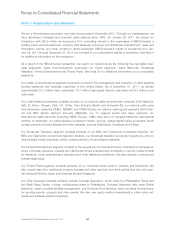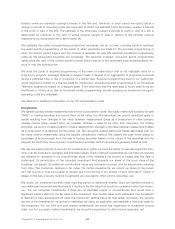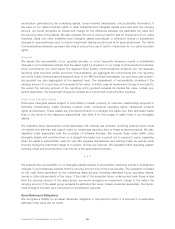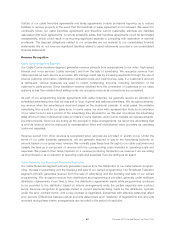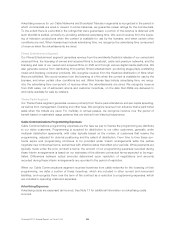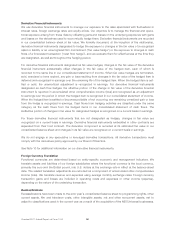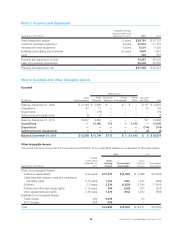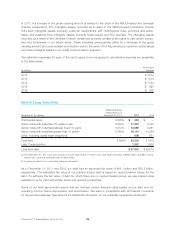Comcast 2011 Annual Report Download - page 92
Download and view the complete annual report
Please find page 92 of the 2011 Comcast annual report below. You can navigate through the pages in the report by either clicking on the pages listed below, or by using the keyword search tool below to find specific information within the annual report.Derivative Financial Instruments
We use derivative financial instruments to manage our exposure to the risks associated with fluctuations in
interest rates, foreign exchange rates and equity prices. Our objective is to manage the financial and opera-
tional exposure arising from these risks by offsetting gains and losses on the underlying exposures with gains
and losses on the derivatives used to economically hedge them. Derivative financial instruments are recorded
in our consolidated balance sheet at fair value. We formally document, at the inception of the relationship,
derivative financial instruments designated to hedge the exposure to changes in the fair value of a recognized
asset or liability or an unrecognized firm commitment (“fair value hedge”) or the exposure to changes in cash
flows of a forecasted transaction (“cash flow hedge”), and we evaluate them for effectiveness at the time they
are designated, as well as throughout the hedging period.
For derivative financial instruments designated as fair value hedges, changes in the fair value of the derivative
financial instrument substantially offset changes in the fair value of the hedged item, each of which is
recorded to the same line in our consolidated statement of income. When fair value hedges are terminated,
sold, exercised or have expired, any gain or loss resulting from changes in the fair value of the hedged item is
deferred and recognized in earnings over the remaining life of the hedged item. When the hedged item is set-
tled or sold, the unamortized adjustment is recognized in earnings. For derivative financial instruments
designated as cash flow hedges, the effective portion of the change in fair value of the derivative financial
instrument is reported in accumulated other comprehensive income (loss) and recognized as an adjustment
to earnings over the period in which the hedged item is recognized in our consolidated statement of income.
When the hedged item is settled or becomes probable of not occurring, any remaining unrealized gain or loss
from the hedge is recognized in earnings. Cash flows from hedging activities are classified under the same
category as the cash flows from the hedged items in our consolidated statement of cash flows. The
ineffective portion of changes in fair value for designated hedges is recognized on a current basis in earnings.
For those derivative financial instruments that are not designated as hedges, changes in fair value are
recognized on a current basis in earnings. Derivative financial instruments embedded in other contracts are
separated from their host contract. The derivative component is recorded at its estimated fair value in our
consolidated balance sheet and changes in its fair value are recognized on a current basis in earnings.
We do not engage in any speculative or leveraged derivative transactions. All derivative transactions must
comply with the derivatives policy approved by our Board of Directors.
See Note 10 for additional information on our derivative financial instruments.
Foreign Currency Translation
Functional currencies are determined based on entity-specific economic and management indicators. We
translate assets and liabilities of our foreign subsidiaries where the functional currency is the local currency,
primarily the euro and the British pound, into U.S. dollars at the exchange rate in effect at the balance sheet
date. The related translation adjustments are recorded as a component of accumulated other comprehensive
income (loss). We translate revenue and expenses using average monthly exchange rates. Foreign currency
transaction gains and losses are included in operating costs and expenses or other income (expense),
depending on the nature of the underlying transaction.
Reclassifications
Reclassifications have been made to the prior year’s consolidated balance sheet to programming rights, other
current assets, film and television costs, other intangible assets, net and other noncurrent assets, net to
adjust to classifications used in the current year as a result of the acquisition of the NBCUniversal businesses.
Comcast 2011 Annual Report on Form 10-K 90




